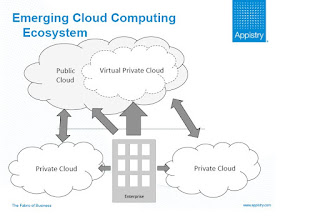Twitter Feed
Transformation Network
The Achilles heel of every transformative business model is their reliance on ever increasing amounts of data that need to be transported quickly across wide area networks and processed at…
Essential Characteristics of Cloud Computing as Digital Transformation
Hybrid IT blends traditional datacenters, managed service providers, and cloud service providers to deliver the necessary mix of information technology services. This IT consumption model enables a composable infrastructure which…
Transformation Innovation
4 Factors Driving Digital Transformation ROI The critical assessment factors for cloud ROI risk probability are the following: Infrastructure utilization Speed of migration to cloud Ability to scale business/mission processes…
Transformation Frameworks
Digital transformation necessitates changes in an organization’s operational processes. According to Harvard, a focus on operations can lead to business process optimization and entirely new revenue streams. Three common routes…
Transformation Infrastructure
Hybrid IT enables a composable infrastructure which describes a framework whose physical compute, storage, and network fabric resources are treated as services. Resources are logically pooled so that administrators need…
Essential Characteristics of Cloud Computing as Digital Transformation
A survey of 2,000 executives conducted by Cognizant in 2016 identified the top five ways digital transformations generate value: Accelerating speed to market Strengthening competitive positioning Boosting revenue growth Raising…
Embrace Transformation
From a business perspective, differentiating business processes and quality customer service are central to overall success. Business leaders must therefore clearly identify and measure how information technology contributes to the…
Computer Vision Advances Zero-Defect Manufacturing
by Kevin L. Jackson Electronics manufacturers operate in a challenging environment. It’s hard enough to keep up with the ever-accelerating rate of change in the industry. Now customers want increasingly…
Real-Time Analytics Power the Roadway of the Future
By Kevin L. Jackson The complexities of citywide traffic are pushing the limits of existing transportation management systems. Outdated infrastructure is based on proprietary, single-purpose subsystems, making it costly to…
Thriving on the Edge: Developing CSP Edge Computing Strategy
Communications Service Providers (CSPs) are facing significant business model challenges. Referred to generally as edge computing, the possibilities introduced by the blending of 5G networks and distributed cloud computing technologies are…
Less than 2% of the CIOs in an Infoworld survey said that cloud computing was a priority. The surveyed indicated that server virtualization and server consolidation are their No. 1 and No. 2 priorities. Following these two are cost cutting, application integration, and datacenter consolidation. At the bottom of the list of IT priorities are grid computing, open source software, content management, and cloud computing (called on-demand/utility computing in the survey).
Since cloud computing is all about virtualization and server consolidation these kind of numbers really concern me? Last week during the SOA-R education session, Bob Lozano of Appistry actually talked about how enterprises are integrating public and private clouds today in order to meet virtualization, consolidation and cost cutting goals. His full presentation is available in the SOA-R Interactive Networking Group wiki.

Elastra is also addressing this enerprise need. They are working on a version of Cloud Server for data center VMware environments, their “private clouds.” The company’s pitch is that IT departments need better tools to specify requirements and configure software to run on physical or virtual servers, regardless of whether the underlying systems are on premises or out in the public cloud. See John Foley’s blog on Information Week in The Rise Of Enterprise-Class Cloud Computing.
Sam Charrington is even more definitive in the Open Web Developer’s Journal:
“We’re still relatively early in the cloud computing hype cycle but I strongly believe that in the future, most if not all server-side software applications will be deployed in a cloud-computing-like manner. That is not to say that all applications will be run in one of exactly five global clouds. On the contrary, every enterprise will have one or more ‘clouds’ into which they deploy applications.”
CIO’s should really re-think their views on cloud computing.
Cloud Computing
- CPUcoin Expands CPU/GPU Power Sharing with Cudo Ventures Enterprise Network Partnership
- CPUcoin Expands CPU/GPU Power Sharing with Cudo Ventures Enterprise Network Partnership
- Route1 Announces Q2 2019 Financial Results
- CPUcoin Expands CPU/GPU Power Sharing with Cudo Ventures Enterprise Network Partnership
- ChannelAdvisor to Present at the D.A. Davidson 18th Annual Technology Conference
Cybersecurity
- Route1 Announces Q2 2019 Financial Results
- FIRST US BANCSHARES, INC. DECLARES CASH DIVIDEND
- Business Continuity Management Planning Solution Market is Expected to Grow ~ US$ 1.6 Bn by the end of 2029 - PMR
- Atos delivers Quantum-Learning-as-a-Service to Xofia to enable artificial intelligence solutions
- New Ares IoT Botnet discovered on Android OS based Set-Top Boxes










